Batman is and has always been this nation’s most valuable export, just above Joss Whedon and “Deadgirl,” by B.C. Johnson (cough). What is it about Batman that appeals to us, nay, to the Earths?
He is just a man (with forty hojillion dollars) and a particularly rigorous exercise program. He fights on, even when his pitiful mortal bones are breaking. He never compromises his integrity, even when chicks are on the line.
Or it could be his rich, elaborate mythos painstakingly developed over seventy years of comic books. The amazing backstories, the incredible storytelling.
And that’s all true, but let’s not forget that no Batman is a bat-island, and that some of the most integral pieces of the Bat-Universe came from unexpected sources . . .
Harley Quinn
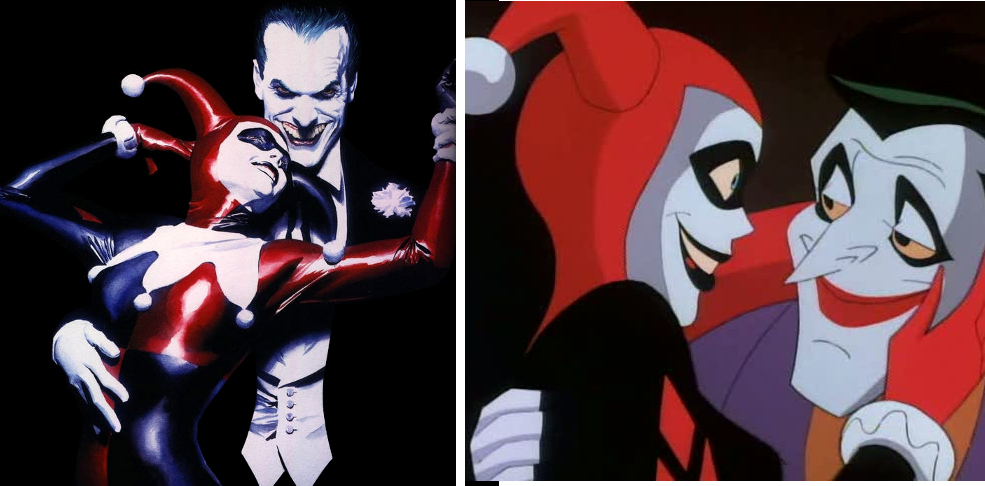
Harley Quinn is without a doubt one of the most fascinating characters in the Batman mythos. And considering the pack of truly deranged, dementia-ridden weirdos that crawl below and above Gotham City, that’s really saying something. This is a city that features a giant crocodile man, an evil mafioso dummy, and a guy who wears an oversized calculator on his chest.
Harley Quinn is the GIRLFRIEND of the Joker. The Joker. The Clown Prince of Crime, the Harlequin of Hate, the White-Faced Marquis of the Macabre, the Cheddar of Cheese, etc. The man who is so crazy that he comes full circle right back around to TOTALLY FUCKING NUTBONES. The Joker doesn’t remember his past because he prefers it to be “multiple choice.” A dude who, currently, wears his own skinned face as a mask. When the Joker jams a barrel of a gun in your mug, there’s about a fifty-fifty chance between it firing a bullet or it depositing a live trout on your face.
That guy. Has a girlfriend. Who loves him dearly, despite multiple domestic homicide attempts and near-constant abuse, both physical and mental. Harley Quinn entered the twisted Gotham game as a psychiatrist – the Joker’s psychiatrist, in fact, in Arkham Asylum. Taking a peak inside the Joker’s brain actually broke her own mind, and she’s been gallivanting at his side ever since with a giant sledgehammer and a pair of pet hyenas. It’s rare to see an appearance of the Joker without Harley at his side – in fact, the live-action Bat-universe is really the only version lacking the Mistress of Mayhem.
And it’s funny to imagine that such an integral part of the Bat-Mythos was created for the Animated Series in 1992, in an episode called “Joker’s Favor.” She’d never appeared in a comic before then, and was created whole-cloth by Paul Dini, who needed a Joker henchman to jump out of a cake at a birthday gone awry but decided it would be ridiculous for a male character to do it. Combine the effervescent, manic sing-song voice of Arleen Sorkin and a balls-rad character design by Bruce Timm, heat to 500 degrees of apeshit wackiness, season to taste.
Since her debut, she was folded into the DC universe comic book canon forever, based off of how totally amazing she was. Imagine a character with Joker’s disregard for life, no real obsession with Batman, no predictable patterns, and the stormy temperament of a tempestuous, spurned girlfriend and you have a character that rivals the Joker himself for instability.
She’s so perfect at the Joker’s side because not only is she fascinating and compelling in her own right (which she absolutely is, oftentimes stealing the spotlight from the Joker himself), but she introduces a whole different dish of insanity to an already overstuffed buffet. In his own twisted way, the Joker does love Harley – and seeing Joker melt a guy’s face with acid, unleash a twisting-metal guffaw, and then turn to Harley and present her with chocolates is surreal.
The Joker is a richer character around Harley, and Harley Quinn’s bubbly, Brooklyn-accented brand of barbarism is insanely arresting. She’s been teamed up with Poison Ivy, the Suicide Squad, the Secret Six, and Catwoman because she is one of those characters you can’t cram into your eyeholes enough. Any scene starring Harley Quinn starts with +15 awesome points, and the writers know it.
It’s hard to imagine a Dark Knight mythology without her.
Mr. Freeze
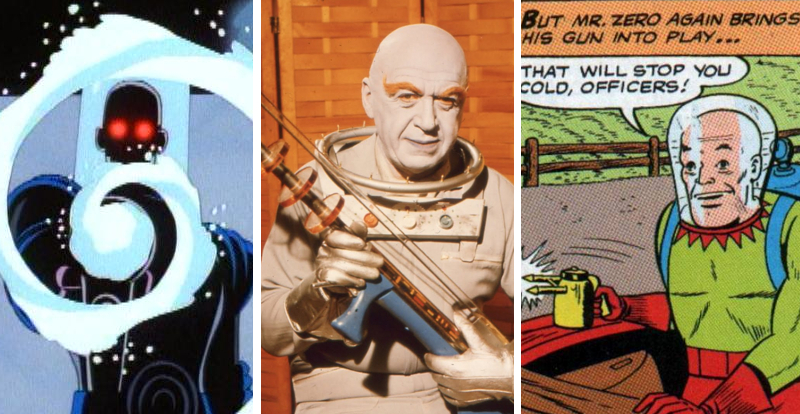
When you ask a Batman fan who is the most dangerous Bat-villain, their facemouth will be forming the vowel shapes for “The Joker, you cow-faced scrote waxer!” before you even finish the question. But if you ask them who is the most tragic Bat-villain? The most relatable? The one who has the highest chance of redemption, even if you know, deep down, that he’ll never get it?
Hear the sad tale of Doctor Victor Fries. The rime-hearted Emperor of Ice, Mr. Freeze is forever trapped in a cold suit that keeps him from feeling warmth, sensation, and even emotion. His beloved wife Nora was stricken with a debilitating, degenerative disease that would ultimately claim her life. Rather than surrendering the love of his life to ugly fate, Freeze, a brilliant scientist, placed her in cryogenic freeze with the intent to use the extra time to find a cure. One horrendous accident later and Nora is frozen forever, but so is Freeze – never to feel love, never to know the touch of the woman he adores, never again to walk in the sunlight. A cold-hearted man with only one thing to live for, Freeze has sacrificed the man he was to save the woman he loves.
Arresting stuff, right? Considering he started in the comics as “Mr. Zero” in 1959, a green-and-orange wearing joke theme character, Freeze has come a long way. This entry is a two-fer: not only did Mr. Freeze’s brilliant personality and backstory not come from the comics, his NAME didn’t even begin there.
He didn’t even get the moniker “Mr. Freeze” until the campy 1960’s Adam West Batman show. There, he appeared as a silly German man with a penchant for ice-puns, an unfortunate characterization that would return for the fan and critic beloved “Batman and Robin: On Ice – The Death of a Franchise; Seriously Joel Schumacher What the Hell Happened – A Song of Nipples and Batawangs: Why Was Batgirl Related to Alfred – The ‘What The Holy Shit’ Story.”
On the ’60s show, he remained a campy joke of a character, but he did get a much better name. It wasn’t until 1992’s “Batman: The Animated Series” (are we sensing a theme here?), however, that he was resurrected as something worthwhile. When his debut episode “Heart of Ice” aired, Freeze hadn’t been in the comics for twenty years. And no, I’m not going to say he was “on ice,” because that’s fucking retarded.
Under Paul Dini’s pen (or possibly word processor), Freeze was transformed, going from walking punchline to marching pathos engine. We’ll never understand the mind of a wingnut like the Joker – but a man who’s loved and lost, like Freeze? That’s a true gothic villain, and a fitting opponent for the Dark Knight.
Without Freeze to prop it up, the Batman Rogue’s Gallery is just a nutter butter potluck, a who’s who of psychological disorders with legs.
Alfred Pennyworth
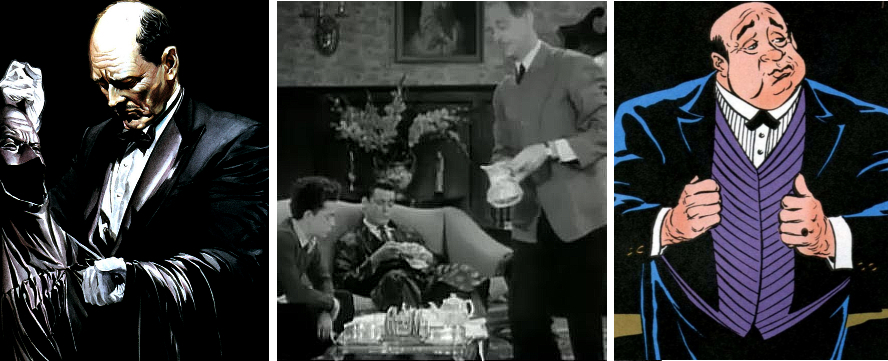
We’re all familiar with Alfred the Butler. Alfred Pennyworth is almost as vital to the Batman mythos as dead parents and ninja training. And we all know Alfred – that fat, balding, sillypants fool who always tries to be a detective but fails miserably, much to the delight of Bruce Wayne and Dick Grayson, the Boy Wonder.
Wait, no, you don’t know that character at all. In his original comic incarnation, Alfred Pennyworth was essentially a stupid asshole – he was a foil designed to show how hypercompetent Bruce was by contrasting him with a chubby, bumbling mouthbreather that couldn’t get a clue if it was on sale at Burger King.
But wait! Alfred is a slim, rapier-witted retired badass, whose massive heart is hidden beneath a tightly-wrapped British flag! Alfred raised Bruce to be the man he is today! Alfred stitches Bruce up with the combat medic know-how he learned when he was in the British special forces as a young man. ALFRED IS MICHAEL CAINE YOU LIAR!
Well, he is now, in the movies and in the comics. But how did he go from Derplock Holmes (. . wait. Sherlock Homoes? Derplock Homoes! Nailed it) to the British billy-badass we know today?
It isn’t “Batman: the Animated Series.” Curveball, bitches. No – the modern look and the beginning of the modern characterization of Alfred began in the 1943 “Batman” movie serials that you and most of the world haven’t seen. Low-budget but earnest affairs, the Batman serials introduced the idea of a live-action Batman to the universe. The ’60s Adam West Batman show that we all know and love used the ’40s Batman serials as direct inspiration.
In the serials, Alfred was played by William Austin, a classy, pencil-thin mustachoied actor with a lean frame and a razor tongue. The comic book writers, seeing the success of the serials, decided to change the “Fatty McDumbshit” version of Alfred into something that more resembled what the audience was seeing on the screen. They even gave an in-universe reason for Alfred’s change – Bruce sent Alfred away to a “health spa” (whale farm) to lose the chubs. Alfred came back healthy and smart, because everyone knows that having excess fat on your body turns you into a moron.
Batgirl
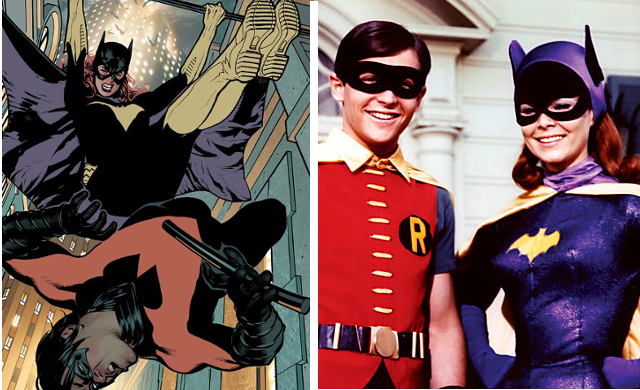
There have been a few Batgirls, but the original, most famous, and current is Barbara Gordon, the red-headed daughter of police Commissioner James Gordon. A staple of the Bat-Family, Batgirl is just as perennial as Robin – she’s appeared in pretty much every incarnation since the beginning.
However, it wasn’t the comics that birthed Batgirl: Batgirl was the original brainchild of a few people, but the seed began with the producers of the 1960’s Adam West show, the one world-famous for ridiculous camp, Adam West, and bat shark repellant. The producers and viewers realized something – other than the occasional appearance by (a very sexy) Catwoman, that entire show was the biggest sausage fest since the Munich SausageCon in 1996. Batman, Robin, O’Hara, Alfred, Joker, Riddler, King Tut, Mr. Freeze, Egghead – that show had less vaginas than an Alaskan Paintball Tournament and Cigar Show.
In an effort to increase equality (or to cram more boobs in skin-tight spandex, you know, whatever), producers colluded with DC Comics editor Julius Schwartz to churn out a brand new female character to introduce in the comics and the show, simultaneously, just as the third season started.
Barbara Gordon was born. She was unique from Robin in that Bruce had no idea who she was, and she operated outside of the official Bat organization. She was an enigmatic character, appearing only in certain episodes (and comics). Plus, there was a fun dynamic where Alfred knew who she was, and was even sneaking her equipment on the side, but was doing so without Bruce’s knowledge.
Also, full disclosure: Yvonne Craig as Batgirl was the first time I ever felt those funny squishy feelings for a girl (or anyone, really), and as a kid I couldn’t figure out why I thought she was so interesting. Whenever it was a “Batgirl episode,” I got unnaturally psyched and sweaty and confused. So yes, the default setting of my sexual barometer is a red-headed supermodel crime fighting librarian dressed like a bat.
And I will accept no less. So thanks, ’60s Batman show. No seriously, thank you.
The Bat-Cave
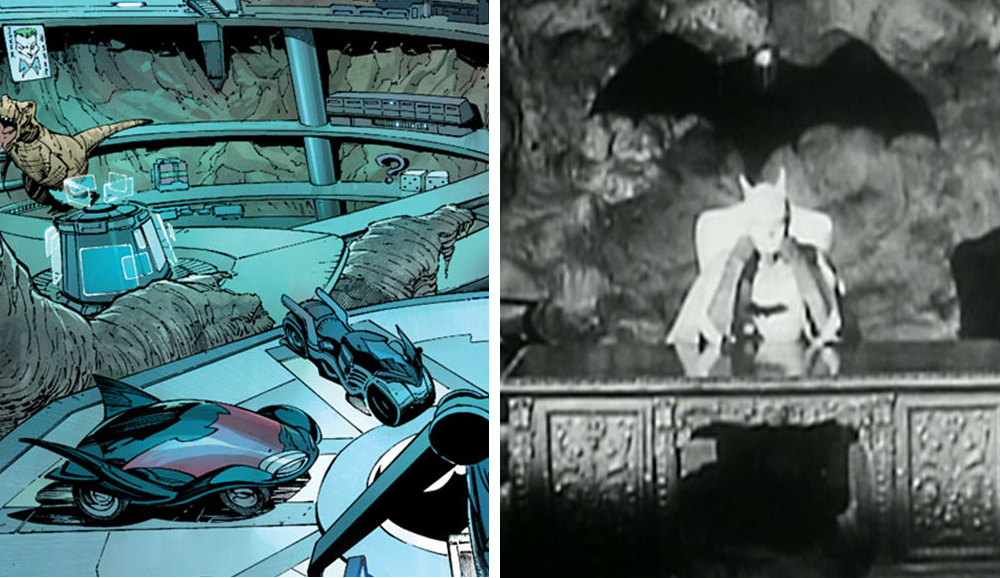
Oh come on, you might say. This is ridiculous, you might say. You are so HANDSOME Bobby, you might say. You’re telling me the freaking Bat-Cave didn’t come from the comics? Did anything?
How about Bruce Wayne? Was he introduced in a radio play? What about punching? Batman didn’t punch criminals until the 1977 off-broadway roller-disco show starring John Travolta as “Jake Batman” and Florence Henderson as “The Indelible Batwoman.” Robin? Originally an elderly Scotsman named “Robbin’ MacDuff” who beat criminals to death with his mystical shillelagh, and it wasn’t until a poem written in 1964 by Henry Kissinger that he became the official Boy Wonder in the comics.
But yes, it’s all true. Well, nothing in that last paragraph, but everything else. Even the Bat-Cave, that most impregnable of sanctuaries, that most lauded homestead, the one place where the Caped Crusader can kick up his bat-boots, crack a bat-lager, and watch his bat-porn didn’t actually originate in the comics.
At the start, Bruce Wayne kept his batmobile and all his crime-busting crap out in the barn. Yeah, just a barn. I hesitate to call it a bat-barn because I don’t think it had any insignias or even dark colored paint splashed around. Shit was real slapdash back when Alfred was still a diabetes risk.
I’m surprised Bruce didn’t park the batwheels in the driveway and just throw a tarp over that sumbitch.
The Bat-Cave (though it wasn’t called that yet) originated from the 1940’s serial, the same one that gave us Alfred’s look and not-ridiculous personality. Their budget could probably slip under a door even if you printed it in ten dollar bills, so there wasn’t a lot of room for extravagance. They needed somewhere for Batman and Robin to scheme up their heroic deeds, and they had an old cave set on hand for use in Buck Rodgers movies, cave man pornography, and Twilight Zone episodes.
In the script, they referred to it as “Bat’s Cave,” and it looked like a smallish bathroom with paper mache on the walls and an English teacher’s desk in the middle. Years later, it would enter the comics as the “Bat Cave” proper, coming eventually to house a robot dinosaur, a giant Joker playing card, a huge penny, and the last vestments of a fallen Robin.
So what’s the moral of the story, kids? Is it to be open minded about adaptations? Is it to always remember how important collaboration is? Is it that Paul Dini should just be the guy in charge of Batman, forever and ever?
No.
The moral is “Don’t Do Drugs.” Were you even paying attention?

“So yes, the default setting of my sexual barometer is a red-headed supermodel crime fighting librarian dressed like a bat.”
Got it covered.
In all seriousness though, great article! Many realizations about where some of the best Batman elements originated! You’re forgetting of course the fundamental laryngitis voice, originating in the most recent movie series (I think?). Ya know, becausea ninja dressed up like a bat with more advanced weapons than the military isn’t scary enough. Gotta have the voice.